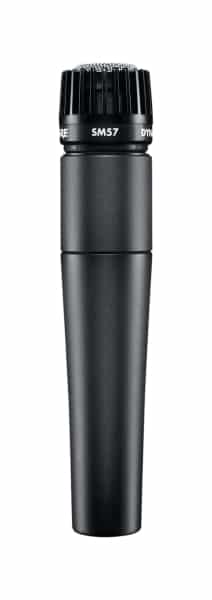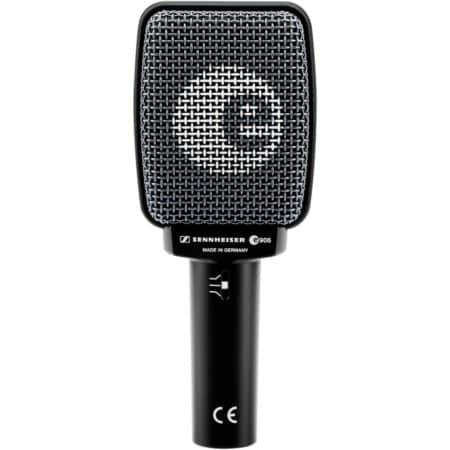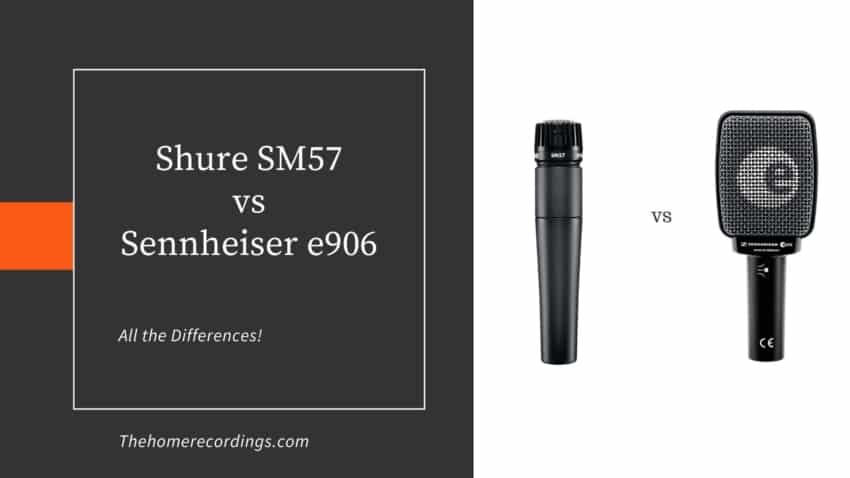Last updated on December 29th, 2023 at 09:58 pm
Everyone knows the Shure SM57, since it has been the standard instrument-recording microphone for decades.
Now, Sennheiser came out with a couple microphones of its own to compete with the SM57, and one of them is the Sennheiser e906.
In this post I will compare both microphones, give you a quick overview of both of them, and lastly give you my opinion on which one you should go with, and yes… I prefer one over the other.
Let’s get into the differences between the two…
Differences between the Shure SM57 and the Sennheiser e906
The Shure SM57 features a cardioid polar pattern while the Sennheiser e906 has a supercardioid polar pattern and a switch that lets you boost or cut the presence frequencies.
Both have a similar sound quality, but the Sennheiser e906 is more versatile thanks to the presence switch.
There is one more difference which is that the e906 has a much lower profile, meaning that it doesn’t take up as much space in front of the amp and is much less likely to get bumped.
Now, let’s take an in-depth look into both microphones and then I will give you my opinion on which one to get.
Shure SM57

Used to record guitar and bass cabinets, drums -especially snares-, and loads of other instruments all over the world, the SM57 is considered to be the best dynamic microphone for recording instruments and has always been the go-to in the music industry.
The reason the SM57 is used for recording instruments is because of the grille:
The SM57 has a built-in grille that’s actually part of the cartridge, which means that the diaphragm of the microphone can be placed a bit closer to the sound source, whereas on other dynamic microphones that have a ball grille that also works as a regular pop filter, you can’t get it as close.
The closer the sound source, the more pronounced the proximity effect will be. So, you could say that the SM57 has a more pronounced proximity effect than most other dynamic microphones.
Additionally, the SM57 has a cardioid pickup pattern, meaning that it will mostly pick up sound coming from the front while rejecting anything from the sides or back.
First, let’s talk about the build quality:
The SM57 is built like an absolute tank; it can literally withstand anything you throw at it like being dropped on the ground, bumps, spills, and much more.
The reason for this is that it needs to be able to survive live shows and the life on the road, so it was designed to do just that.
The SM57 has an increased presence peak, which would be in the higher mids/high frequencies.
This means that vocals, for example, will cut better through the mix, and so will electric guitars.
How does it perform?
I use the SM57 to record almost anything, and it really is a very versatile microphone since it can be used on vocals, with a good pop filter in front of it otherwise the plosives will be too much, on electric guitar cabinets, to record drums, and it’s designed to be used both in the studio and on stage.
I love recording my electric guitar with it since the sound is clear, warm and also has a nice low-end, and when recording clean tones, I don’t hear any particular frequencies being too prominent.
As far as high-gain tones go, it doesn’t sound muddy at all but it definitely picks up quite a lot of the lower/low mid frequencies, which is something that doesn’t happen with the Sennheiser e906, and the mids and highs do sound a bit “muffled”, for lack of a better term; they don’t sound as clear, at least not to me.
Features
- Most Popular dynamic mic in the world
- Great at recording almost any instrument
- Excellent for close-miking
- Perfect for studio and live shows
Specifications
| Polar Pattern | Cardioid |
| Microphone type | Dynamic |
| Frequency Response | 40 to 15,000 Hz |
| Output Impedance | Rated impedance is 150 Ohms (300 Ohms actual) |
| Connector | Three-pin (XLR), male |
| Sensitivity | -56dB |
Find out more about the Shure SM57 here:
- Shure SM57: Amazon, Sweetwater.
Note: You might be interested in learning more about other dynamic microphones, so here are a couple posts I wrote that should help you out:
Sennheiser e906

The Sennheiser e906 looks to be the upgraded version of the e609, which is another instrument-specific microphone I reviewed some time ago.
The differences between the two lie mainly in the presence control switch that is included in the e906, but not in the e609, which basically means that it’s a more versatile microphone.
I’m very happy that they not only decided to include a presence boost, but also a presence cut, and this can really come in handy at times, even though I have to admit that I never ended up using the presence cut… maybe you will.
Now, as far as build quality goes, I definitely can’t complain; there’s only a bit of give on the middle of the grille, but that’s really it since everything else is extremely well put together.
Like I mentioned in the beginning, the e906 has a much smaller profile than the SM57, which means that when placed in front of an amp it should take up less space and if used on a live stage, it should be harder for someone to accidentally bump up against it.
Lastly, the Sennheiser e906 is very susceptible to plosives, which shouldn’t really matter that much since it’s designed to record instruments, but if you ever decide to use it as a vocal mic, keep in mind that a good pop filter will be required.
Now to the important part; sound quality!
How does it perform?
As far as recording electric guitar cabinets go, I really can’t complain; the sound sounds full with a good amount of low end without sounding boomy, and the mids and highs also sound great.
Now, more often than not, I like engaging the presence boost since it helps my guitar to better sit in the mix, but this might depend on your preferences.
However, I didn’t really enjoy the presence cut, even though I admit that it might come in handy, but when recording electric guitar, especially with some gain on it, the sound comes off a bit muffled.
Basically, having the presence switch does provide you with a lot more options, I just think that most people will either be using the boost or just leave it flat.
Lastly, if used near a drum set or bass cabinet, it might pick up some of that low-end rumble, so pay special attention to that.
What comes in the box?
- The Sennheiser e906 Microphone
- Microphone Clip
- Carrying Pouch
Features
- Instrument-specific microphone
- Supercardioid polar pattern
- Excellent build quality
Specification
| Polar Pattern | Supercardioid |
| Microphone type | Dynamic |
| Frequency Response | 40 to 15,000 Hz |
| Output Impedance | Nominal Impedance 350 Ohms |
| Connector | Three-pin (XLR), male |
| Sensitivity | -56.5dB |
Find out more about the Sennheiser e906 here:
Sennheiser e906: Amazon, Sweetwater.
My recommendation
When I compared the Shure SM57 to the Sennheiser e609, I ended up preferring the e609 for recording guitar cabinets because the sound was a bit clearer, but both microphone cost roughly the same.
However, in this particular case, since the e906 sells for almost twice as much as the SM57, and even though the presence control switch might be a very nice feature to have, I’d have to recommend the Shure SM57 simply because as far as cost-efficiency goes (affiliate link), it’s better.
If you don’t have budgetary restrictions, then the Sennheiser e906 (affiliate link) is the obvious choice.
Conclusion
Both microphones are absolutely fantastic, plus they are quite affordable when compared to other similar-sounding ones.
Of course, the best way to go about this is to get both, but if you’re on a budget and can only choose one, then the SM57 should be your choice.
I hope you have a nice day and see you on the next one!
